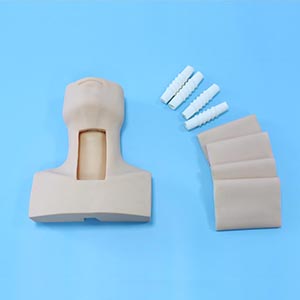Homepageпјҡ NEWS >> Can advanced tracheotomy intubation training model improve the efficiency of emergency team collaboration?
Tracheotomy intubation is a complex and technically demanding procedure in emergency care and intensive care, especially in emergency situations. To improve patient survival, emergency teams must be able to collaborate quickly and efficiently. Traditional tracheal intubation training focuses on the improvement of individual skills, but with the progress of medical technology, team cooperation training is becoming more and more important. The introduction of advanced tracheotomy intubation training model provides a simulation environment for emergency team to conduct team cooperation training in simulated real emergency intubation situation. Through this training, team members are able to collaborate more efficiently and achieve higher success rates in actual operations.
Advanced tracheotomy intubation training model: the key to team collaboration

Advanced tracheotomy intubation training model
1. Multidisciplinary collaborative training
The advanced tracheotomy intubation training model can simulate the interaction of multiple emergency roles at the same time, such as doctors, nurses, anesthesiologists, emergency personnel, etc. Through this multi-role training mode, team members can find the best way to cooperate among each other. Each member can play their role in a simulated situation and learn how to quickly and accurately collaborate with other members to complete the tracheotomy intubation operation. This kind of simulation training helps to strengthen the communication and collaboration ability among team members and improve the smoothness and efficiency of operation.
2. Real-time feedback and adjustment
Modern advanced training models are equipped with real-time feedback systems that monitor and evaluate the team's operations during training. The system not only provides feedback on the actions of individual students, but also analyzes the operational processes and collaborative efficiency of the team as a whole. For example, if there is a delay or error in a link, the system will give immediate feedback and provide suggestions for improvement. Through this real-time feedback mechanism, teams can quickly adjust strategies and optimize operational processes, thereby improving collaboration efficiency.

3. Simulate team reactions in high-pressure environments
Advanced tracheotomy intubation training models often simulate highly stressful and stressful emergency environments. This situation helps team members stay calm and react quickly under pressure. Through repeated training, the team can quickly coordinate and cooperate in the face of emergencies, avoiding the delay of rescue time due to confusion or mistakes in operation. Research has shown that teams trained in such stressful situations are able to work together more effectively in real-world first aid, significantly improving operational success and patient survival.
Data support: Increased collaboration efficiency
According to a study of 300 emergency team members, teams trained collaboratively using the advanced tracheotomy intubation training model saw a 25 percent improvement in the success rate of intubation operations and a 30 percent reduction in overall operation time. In the teamwork training, the degree of cooperation between the trainees was significantly improved, the communication between the team members was more smooth, and the coordination during the intubation process was significantly enhanced. In addition, the team that participated in the training experienced a 35 percent increase in the probability of successful intubation when faced with a complex condition or difficult airway.

Another study showed that after more than 10 sessions of teamwork training, emergency teams reduced their response time in emergency situations by 15 percent and the frequency of errors during intubation by 20 percent. These data show that with the advanced tracheotomy intubation training model, the team's collaborative efficiency and emergency response ability have been significantly improved.
Clinical significance: Improve the clinical effect of emergency team cooperation
Tracheotomy intubation is commonly used in severe patients, patients with respiratory failure or complex emergency situations. In these emergency situations, the success of intubation is directly related to the patient's life safety. Therefore, efficient teamwork is particularly important. The advanced tracheotomy intubation training model not only improves the coordination among team members, but also helps the team make rapid decisions in the face of complex cases and optimizes the emergency operation process.

In addition, through team cooperation training, members can better understand their respective responsibilities and tasks, avoid blurring responsibilities, overlapping operations or omissions, and improve overall operational efficiency. In practice, teams trained in this way are able to perform tracheotomy intubations more efficiently, reducing the risk to patients due to delays or improper intubation.
conclusion
The advanced tracheotomy intubation training model can not only improve the intubation skills of individual students, but also significantly improve the collaborative efficiency of emergency teams. By simulating real first aid scenarios, students can learn how to work together in a multi-role environment, make quick decisions, and optimize operational processes. Data and studies have shown that teams trained in teamwork have significantly improved intubation success rates, operating times, and emergency response capabilities, enabling more efficient and safer emergency care for patients in the clinic. Therefore, with the help of advanced training model, the cooperation ability of emergency team has been effectively strengthened, which provides strong support for improving the quality of clinical emergency and patient survival rate.